Dual-band GNSS white paper
Single-band vs. dual-band GNSS: which is the right choice for your project?
Read white paper
Dual-band GNSS delivers higher accuracy, but with greater complexity and cost
GNSS deployments are growing steadily, with increases in potential use cases for location technologies and democratized access to GNSS. Annual shipments will rise from 1.6 billion units in 2023 to 2.2 billion in 2033, with consumer electronics and automotive applications accounting for most of the demand. This growth is driving developers to find the right balance between performance, cost, and energy efficiency so they can make the most of these growing opportunities. Among the technology choices, the role of dual-band GNSS is expanding, although single-band receivers remain highly relevant and indeed preferable for many use cases.
Single-band GNSS, operating on the L1 frequency band, is popular for its lower cost, simpler design, and smaller antenna requirements. Under open-sky conditions, single-band solutions generally achieve 2–3 meter accuracy. Dual-band GNSS typically uses both L1 and L5 frequencies, offering accuracy of one meter or better in open-sky scenarios when paired with an optimized antenna. It is also more resilient to jamming and multipath interference, which makes it valuable in dense urban environments. However, these benefits come at a cost. Dual-band GNSS modules are typically 50–100% more expensive, require larger antennas, consume more power, and involve more complex engineering.
Dual-band GNSS technology delivers greater accuracy, but the question of whether single-band or dual-band GNSS is better has to be considered for each use case. A wide range of factors influence overall performance, including technology, antenna design, the GNSS platform, power budget and cost. Making the right choice means deciding the right trade-offs for each device.
Deciding between single-band or dual-band GNSS is however only part of the design process. Factors such as antenna size, chipset selection, low-power operating modes, and update frequency also shape performance. These elements vary significantly from product to product, and the optimal combination depends heavily on the intended application.
Antenna size for example can greatly influence accuracy and power consumption. Meanwhile, chipset performance differs between vendors based on their priorities, whether that is low power, maximum precision, or cost-effectiveness. Similarly, the choice of low-power modes and update rates affect energy use but may also affect accuracy or responsiveness. All these variables interact, meaning that decisions in one area often impact the others.
Because of this complexity, GNSS system design benefits from specialist expertise. Experienced engineers can assess the trade-offs between performance, cost, and power efficiency, and recommend the most suitable combination of frequency bands, antenna design, and platform features to match the specific needs of each product.
Relevant products
There is no single “best” choice between single-band GNSS and dual-band GNSS – the right option depends on the application and environment. Dual-band GNSS offers higher accuracy and better resistance to jamming, particularly when larger antennas, higher power use, and greater engineering effort are acceptable. Single-band GNSS remains a cost-effective option for compact, power-sensitive devices, especially where antenna space is limited and conditions less demanding. In open-sky environments, its performance can approach that of dual-band systems.
Because these trade-offs vary by product, expert input is invaluable. Quectel’s engineers can recommend the best combination of frequency, antenna design, and platform features for your specific needs. Read our free new white paper on considerations around dual-band GNSS and low-power GNSS for more detail, and please feel free to contact us to discuss your project.


